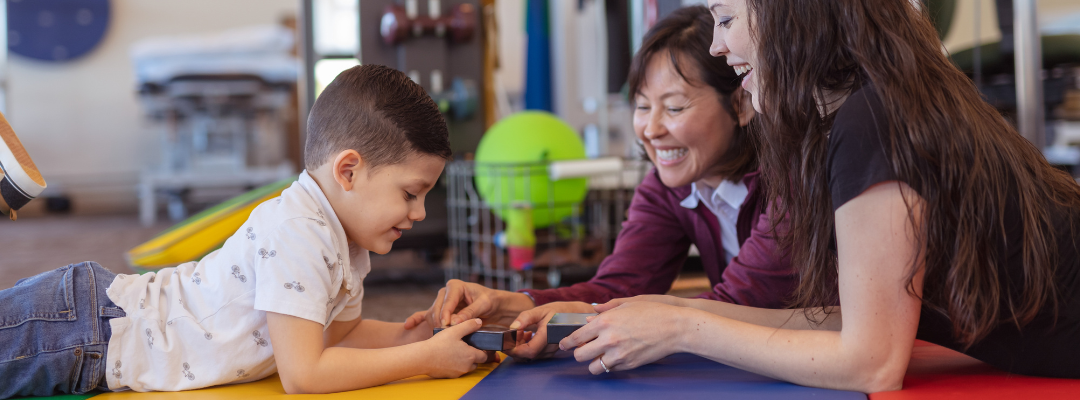Combining speech and occupational therapy can be a game-changer for many children. We understand that every child has unique needs, so integrating these two therapies can offer a comprehensive approach to their development. Speech therapy improves communication skills, while occupational therapy enhances daily living skills. Together, they provide a well-rounded approach to overcoming various challenges.
When speech and occupational therapists work together, they can address multiple areas simultaneously. The benefits extend beyond the therapy sessions as children learn to apply their new skills in daily life. Whether speaking more clearly, improving handwriting, or becoming more independent in daily tasks, the combined approach offers robust support that helps children reach their full potential.
What is Speech and Occupational Therapy Co-Treatment?
Speech and Occupational Therapy Co-Treatment involves having a speech-language pathologist (SLP) and an occupational therapist (OT) work with a child during the same therapy session. This collaborative approach aims to address multiple areas of development simultaneously, providing a more comprehensive treatment plan. By combining their expertise, the therapists can create activities supporting the child’s speech, motor, cognitive, and social skills.
For example, if a child struggles with speech articulation and fine motor control, the SLP and OT can design activities targeting both areas. They might use games that require the child to speak clearly while manipulating small objects, which helps improve both speech and hand-eye coordination. This co-treatment ensures that therapy sessions are more holistic and tailored to the child’s needs.
Co-treatment also allows for real-time adjustments based on how the child responds to the activities. If one technique isn’t working, the therapists can quickly pivot and try a different approach. This flexibility makes finding what works best for each child easier, increasing the likelihood of positive outcomes.
Benefits of Combining Speech and Occupational Therapy
Combining speech and occupational therapy offers several critical benefits for children. One of the most significant advantages is the integrated approach to tackling multiple challenges simultaneously. Children can make more consistent and well-rounded progress by addressing various skill areas in one session. This comprehensive treatment often leads to quicker and more noticeable improvements in speech and motor skills.
1. Enhanced Coordination: Co-treatment can improve a child’s overall coordination. When therapists design activities that require simultaneous speech and movement, the child better integrates these skills. This coordination is essential for tasks like conversations while engaging in activities at school or home.
2. Holistic Development: Co-treatment sessions are designed to be holistic, addressing the child’s overall development. This means cognitive, social, and emotional growth and speech and motor skills are also considered. This well-rounded approach ensures that no aspect of the child’s development is overlooked.
3. Efficient Progress: Children often see faster progress since multiple skills are being worked on simultaneously. This efficiency can significantly benefit children who must catch up in various developmental areas. The structured yet flexible sessions allow for rapid improvement without overwhelming the child.
4. Increased Engagement: Activities that combine speech and occupational tasks are often more fun and stimulating for children. This higher level of engagement keeps them motivated and focused, making therapy more enjoyable and effective.
Combining speech and occupational therapy enriches and supports children’s therapy experience. This approach addresses their immediate needs and sets a strong foundation for future development.
How Co-Treatment Sessions Work
Co-treatment sessions with a speech-language pathologist (SLP) and an occupational therapist (OT) are carefully planned to maximize each child’s benefits. Therapists create activities that target the child’s specific needs during these sessions. For instance, a session might start with an activity involving fine motor skills, like building with small blocks, while encouraging the child to name colors or shapes, boosting both motor and speech skills.
In each session, the child’s progress is closely monitored. Both therapists can observe how the child handles tasks and how well they integrate the skills being taught. If one part of the activity is particularly challenging, therapists can adjust the task immediately, ensuring it remains engaging and beneficial. This real-time adaptability helps keep the child motivated and supports continuous improvement.
Sessions typically include a mix of individual and group tasks. Individual tasks focus on specific skill development, while group tasks encourage peer interaction and social skill building. For example, a group activity may involve taking turns in a game, which helps with communication and socialization. By the end of each session, therapists review what was effective and plan for the next steps, ensuring each session builds on the last.
Tips for Parents to Support Co-Treatment at Home
Parents play a crucial role in reinforcing the skills learned during co-treatment sessions. Here are some tips to help support your child’s progress at home:
1. Create a Routine: Consistency is critical. Set a daily routine that includes time for practicing speech and motor skills. Even simple daily activities, like meal times or getting dressed, can be practice opportunities.
2. Use Everyday Objects: You don’t need special equipment to support your child’s development. Use everyday objects like kitchen utensils or craft supplies to create fun, skill-building activities. For example, let your child help with cooking to practice following directions and using fine motor skills.
3. Encourage Social Interaction: Arrange playdates with other children to help your child practice social skills. Structured games or activities where children take turns and communicate can be very beneficial.
4. Positive Reinforcement: Always praise your child’s efforts, not just the results. Positive reinforcement encourages continued effort and builds confidence. Celebrate both big and small achievements to keep your child motivated.
5. Communicate with Therapists: Stay in touch with your child’s therapists to understand what skills they are focusing on. They can provide specific activities and tips tailored to your child’s needs, ensuring consistency between therapy sessions and home practice.
Conclusion
Combining speech and occupational therapy offers a robust, well-rounded approach to helping children overcome various developmental challenges. By integrating these therapies, children can work on multiple skills simultaneously, leading to more efficient and comprehensive progress. This combined approach addresses immediate needs and lays the foundation for long-term success in communication, daily living, and social interactions.
Parents play a vital role in this process. By supporting your child at home with consistent routines, engaging activities, and positive reinforcement, you can help reinforce the skills they learn in therapy. Staying in touch with therapists and incorporating their advice into daily life can significantly enhance your child’s progress and confidence.
If you believe your child could benefit from a combined speech and occupational therapy approach, consider reaching out to Watch Me Shine. Our expert therapists are here to provide the support and guidance your child needs to thrive. Contact us today to learn more about how our therapy services can help your child reach their full potential.

